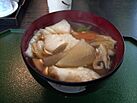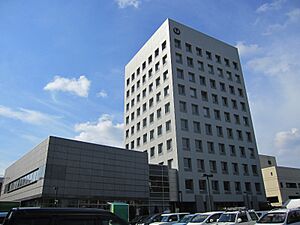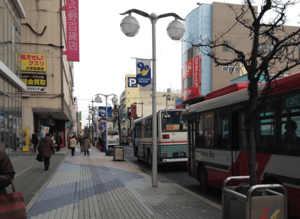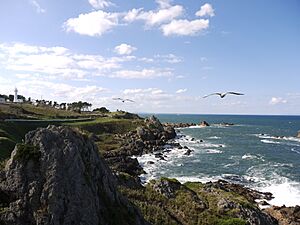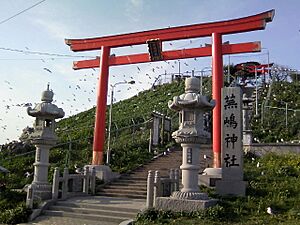Hachinohe facts for kids
Quick facts for kids
Hachinohe
八戸市
|
|||||||||||||
|---|---|---|---|---|---|---|---|---|---|---|---|---|---|
|
|||||||||||||
|
|||||||||||||
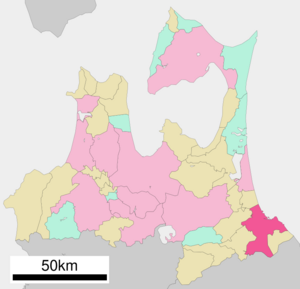 |
|||||||||||||
| Country | |||||||||||||
| Region | Tōhoku | ||||||||||||
| Prefecture | Aomori | ||||||||||||
| Area | |||||||||||||
| • Total | 305.56 km2 (117.98 sq mi) | ||||||||||||
| Population
(August 1, 2023)
|
|||||||||||||
| • Total | 216,416 | ||||||||||||
| • Density | 708.260/km2 (1,834.39/sq mi) | ||||||||||||
| Time zone | UTC+9 (Japan Standard Time) | ||||||||||||
| Phone number | 0178-43-2111 | ||||||||||||
| Address | 1-1-1 Uchimaru, Hachinohe-shi, Aomori-ken 031-8686 | ||||||||||||
| Climate | Cfa/Dfa | ||||||||||||
|
|||||||||||||
Hachinohe (pronounced HAH-chee-noh-heh) is a cool city in Aomori Prefecture, Japan. As of August 2023, about 216,416 people live here. It's the second largest city in Aomori by population. Hachinohe covers an area of about 305.56 square kilometers (117.98 square miles).
Contents
- Exploring Hachinohe's Location
- How Many People Live in Hachinohe?
- A Look Back at Hachinohe's History
- Hachinohe's Economy and Industries
- Learning in Hachinohe
- Getting Around Hachinohe
- Fun Things to See and Do in Hachinohe
- Sports Teams in Hachinohe
- Hachinohe's Sister Cities
- Famous People from Hachinohe
- Other Cool Facts
- See also
Exploring Hachinohe's Location
Hachinohe is on the flat southeastern coast of Aomori Prefecture. It faces the huge Pacific Ocean. Two rivers, the Oirase River and the Mabechi River, flow through the city. Some of Hachinohe's coastal areas are part of the Sanriku Fukkō National Park. This park is a beautiful natural area.
Nearby Towns and Cities
Hachinohe is surrounded by other towns and districts. These include:
- Karumai in Iwate Prefecture
- Oirase in Kamikita District
- Gonohe in Sannohe District
- Hashikami in Sannohe District
- Nanbu in Sannohe District
Hachinohe's Weather
Hachinohe has a humid continental climate. This means it has warm summers and cold, snowy winters. Summers are usually milder than in other parts of Honshu because Hachinohe is close to the sea. Winters are cold but get less snow than cities like Aomori or Sapporo. The average yearly temperature is about 9.9°C (49.8°F). September is usually the wettest month.
How Many People Live in Hachinohe?
The number of people living in Hachinohe has changed over the years. Here's a look at the population from past records:
| Historical population | ||
|---|---|---|
| Year | Pop. | ±% |
| 1960 | 184,680 | — |
| 1970 | 216,955 | +17.5% |
| 1980 | 245,617 | +13.2% |
| 1990 | 247,983 | +1.0% |
| 2000 | 248,608 | +0.3% |
| 2010 | 237,473 | −4.5% |
| 2020 | 226,541 | −4.6% |
A Look Back at Hachinohe's History
The area where Hachinohe is located has been home to people for a very long time. Ancient remains from the Jōmon period (a time in Japanese prehistory) have been found here.
From Clans to Castles
During the Heian period, the area was controlled by the Northern Fujiwara family. Later, the Nanbu clan took over. The Nanbu clan was known for its horse ranches and built many fortified settlements. In the Edo period, a special area called Hachinohe Domain was created for a branch of the Nanbu clan. Hachinohe grew into a busy castle town around Hachinohe Castle. It became an important center for trade and a port for fishing. Even today, the port is still very important for fishing and international cargo ships.
Becoming a Modern City
After the Meiji Restoration, the old domain system changed. Hachinohe became part of Aomori Prefecture. There was a debate about where the capital of Aomori Prefecture should be. Because of rivalries between different clans, the government decided to build a new city, Aomori, in a central spot and make it the capital.
Hachinohe officially became a town in 1889. Over the years, it merged with several nearby villages to become the city we know today. In 2005, the village of Nangō also joined Hachinohe.
Hachinohe in Recent Times
After World War II, the United States Army had a base called Camp Haugen in Hachinohe. Soldiers from this base went to Korea in 1950 during the Korean War. The base was later given to the Japan Ground Self-Defense Force in 1956.
In March 2011, Hachinohe was hit by the 2011 Japanese tsunami. Many fishing boats were washed ashore, and the port was badly damaged. About 100 homes were destroyed. Workers from the United States Navy helped clear the port to bring in relief supplies.
On January 1, 2017, Hachinohe was given "core city" status. This means it has more control over its own local government.
Hachinohe's Economy and Industries
Hachinohe is the biggest city in eastern Aomori Prefecture. It's a major center for industry and business.
Fishing and Factories
Commercial fishing is still a huge part of Hachinohe's economy. The Port of Hachinohe handles one of the largest amounts of fish in Japan! Since 1964, Hachinohe has also grown into a big industrial area along the coast. Factories here make many different things, like chemicals, steel, cement, and fertilizers. There are also large industrial parks, such as the Hachinohe High Tech Park. The Hachinohe Thermal Power Station, which uses natural gas, is also located here.
Learning in Hachinohe
Hachinohe has many schools and colleges for students of all ages.
Colleges and Universities
- Hachinohe Gakuin Junior College
- Hachinohe Gakuin University
- Hachinohe Institute of Technology
Schools for Kids and Teens
The city government runs 42 public elementary schools and 24 public junior high schools. There are also two private middle schools. For high school, there are eight public high schools run by Aomori Prefecture and one run by the national government. Eight private high schools are also available. Hachinohe also has three special education schools.
Getting Around Hachinohe
Hachinohe has good transportation options, including trains, highways, and a seaport.
Train Travel
You can travel by train using these lines:
 East Japan Railway Company (JR East) - Tōhoku Shinkansen (bullet train)
East Japan Railway Company (JR East) - Tōhoku Shinkansen (bullet train)
- Hachinohe
 East Japan Railway Company (JR East) - Hachinohe Line
East Japan Railway Company (JR East) - Hachinohe Line
- Hachinohe - Naganawashiro - Hon-Hachinohe - Konakano, Mutsu-Minato - Shirogane - Same - Mutsu-Shirahama - Tanesashi-Kaigan - Ōkuki - Kanehama
 Aoimori Railway Company - Aoimori Railway Line
Aoimori Railway Company - Aoimori Railway Line
- Kita-Takaiwa - Hachinohe - Mutsu-Ichikawa
- Hachinohe Rinkai Railway (This line is only for freight trains.)
Major Roads
Several important highways pass through or near Hachinohe:
 Hachinohe Expressway
Hachinohe Expressway Momoishi Toll Road
Momoishi Toll Road Hachinohe-Kuji Expressway
Hachinohe-Kuji Expressway National Route 45
National Route 45 National Route 104
National Route 104 National Route 340
National Route 340 National Route 454
National Route 454
Seaport
The Port of Hachinohe is a very important international port for northern Japan.
Fun Things to See and Do in Hachinohe
Traditional Crafts
- Yawata-uma are special wooden horse figurines. They have gold saddles and decorative plumes. The Hachinohe area has been famous for its horses for a long time. These horse figurines are a popular souvenir.
Cool Places to Visit
- Kabushima is an island near Hachinohe. It's home to about forty thousand black-tailed gulls, also called umineko. It's a special national natural monument. There's also a shinto shrine on the island.
- Kushihiki Hachimangū is another important shrine.
- Tanesashi Coast is a beautiful coastal area. It's recognized as a national Place of Scenic Beauty.
- Yomasari Dam is a large dam in the area.
Exciting Local Festivals
- Emburi is a citywide festival that happens in February. People celebrate it to wish for a good harvest in the coming year. It started as a dance using a farming tool. Today, it's a parade with dancers and musicians playing flutes, drums, and bells. It marks the end of the long winter.
- Hachinohe Sansha Taisai is considered the main festival of Hachinohe. It's even called "Japan's Biggest Float Festival"! Sansha means "three shrines," and Taisai means "festival." Three Shinto shrines hold this festival together. Huge, decorated floats parade through the streets. People play drums and flutes, and there are men in samurai costumes on horseback. You can also see tiger dancers! A traditional sport similar to polo is played on the second and third days. This festival takes place every year from July 31 to August 4.
Important Historical Sites
Hachinohe has several National Historic Sites that teach us about the past:
- Chōshichiyachi Shell Mound: Remains from the ancient Jōmon period.
- Korekawa Site: More ruins from the Jōmon period.
- Ne Castle: The ruins of a castle from the Muromachi period.
- Tangotai Kofun cluster: Ancient burial mounds from the Kofun period.
Other Interesting Facts
- The unique sound of the umi-neko at Hachinohe was chosen by the Ministry of the Environment as one of the 100 Soundscapes of Japan.
Sports Teams in Hachinohe
Hachinohe is home to a few sports teams:
- Tohoku Free Blades: An Asia League Ice Hockey team.
- Vanraure Hachinohe: A J-League soccer team.
Hachinohe's Sister Cities
Hachinohe has special connections with cities in other countries:
 Federal Way, Washington, United States
Federal Way, Washington, United States Lanzhou, Gansu, China (since April 1998)
Lanzhou, Gansu, China (since April 1998)
Famous People from Hachinohe
Many talented people come from Hachinohe, including:
- Saeko Chiba, a voice actress
- Miki Furukawa, a musician
- Kengo Hanazawa, a manga artist
- Chiharu Icho, a freestyle wrestler
- Kaori Icho, a freestyle wrestler
- Masako Katsuki, a voice actress
- Hitomi Obara, a freestyle wrestler
- Tadamori Oshima, a politician
- Marimo Ragawa, a manga artist
Other Cool Facts
- There's even an asteroid in space named Hachinohe!
See also
 In Spanish: Hachinohe para niños
In Spanish: Hachinohe para niños






